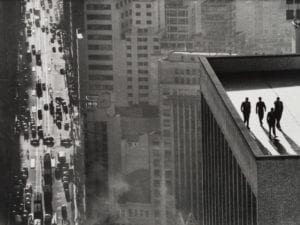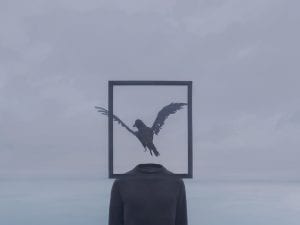After the Agreement: Contemporary Photography in Northern Ireland draws on conversations prompted by the photographs of John Duncan, Kai Olaf Hesse, Mary McIntyre, David Farrell, Paul Seawright and Malcolm Craig Gilbert, in order to trace some of the hesitancies and compulsions that shape interpretation and meaning in the wake of the 1998 Good Friday Agreement. Spanning the themes of Spectrality and Urbanism, Place as Archive and Between Memory and Mourning, the publication frames photographs as agonistic spaces where the meanings of post-conflict and post-Agreement are opened to debate. We speak to editor and cultural practitioner Sarah Tuck about her socially engaged research and the inspiration behind this critical exploration of photography in Belfast.
A: After the Agreement is a survey of contemporary photography in Ireland after the Good Friday Agreement of 1998. How does the publication address the complex themes associated with the time?
ST: The publication is a transcription of conversations prompted by photographs, where the meanings of post Agreement are both the subject and the object of enquiry and contestation. It is therefore a process which both speaks of and responds to the context of post Agreement and equally speaks of and responds to the complex time of photographs.
A: The collection reveals an intimate account of life in Ireland in the late 1980s and early 1990s. What drew you to the work of John Duncan, Kai Olaf Hesse and other featured photographers?
ST: I would suggest that the publication primarily reveals an account of now – insofar as the present provides the fulcrum from which the past is remembered and forgotten, and the future is imagined and anticipated. The pairing of the photographers – John Duncan and Kai Olaf Hesse; Mary McIntyre and David Farrell; Paul Seawright and Malcolm Craig Gilbert – is in response to the curatorial enquiry into the themes Spectrality and Urbanism, Place as Archive, and Between Memory and Mourning. As such, the work of the featured photographers provide different perspectives on the time and place of Northern Ireland that opens out into a broader examination of issues of territory, identity and subjectivity.
A: Your practice orientates itself around in-depth research and socially engaged projects. In your opinion, how does this compare to more traditional process-based practices such as sculpture?
ST: I am interested in what emerges when different narrative and visual strategies are linked, when new disciplinary affiliations take shape. This question of what forms of knowledge are catalysed through collaborative enquiry and experience is central to my practice – which seeks to trace how meaning is culturally and socially produced. So in many ways my practice is about the dramaturgy of discontinuities and dissensus rather than the construction of a point of view which traditional practices such as sculpture would be more inclined toward.
A: Why are collaborative artworks of interest to you, and who have you worked with in the past?
ST: Collaborative artworks provide the scope and potential for context-specific histories to be called into question, explored and examined. I was previously the Director of Create, the national development agency for collaborative arts in the Republic of Ireland. During my time with Create, there were extraordinary projects realised with communities of interest and place and across art forms – notably Seamus Nolan’s Hotel Ballymun which opened a temporary hotel ‘staffed’ by local residents in a tower block that was marked for demolition, providing a critical commentary on regeneration and poverty tourism; Sean Lynch’s investigations into the co-temporal qualities of the known, forgotten and remembered place of Clanbrassil Street in Dublin and Rhona Byrne’s project Home that facilitated expressions of desires and hopes for the future through the return flight path of homing pigeons to a community.
A: After the Agreement presents photographs as agonistic spaces. In your opinion, how does the medium of photography and print offer new interpretations of post-conflict and post-Agreement?
ST: The three discursive events transcribed in After the Agreement underscore how a photograph is a form of address and exchange, of affect and sociability, of the private and the public, the lived and the imagined. In consequence After the Agreement offers itself as part of this explorative negotiation of meaning. A negotiation that is legible in each of the events and cumulatively across the series, which staged what it means to think and feel publicly in the complex conditions of post Agreement. The dialogues produced in response to the images follow a set of paths with no one outcome, and so move away from dogmatic conceptions of photographic meaning to register the disjunctive space of a photograph as a potent and affective site of negotiation. It becomes a space through which lived experience and the imaginary, feeling and thinking, work in tandem in the process of making sense of images, and the time and place of post Agreement. In this way the images of the six photographers as the generative source of the conversations both established and deconstructed the ways in which identity politics are articulated and made foundational to the social and political life of Northern Ireland, and provided a mechanism through which the promise of ‘post conflict’ could be thought and felt as a collective task.
Sarah Tuck, After the Agreement: Contemporary Photography in Northern Ireland, available now from black dog publishing.
Find out more: www.blackdogonline.com/photography/after-the-agreement.
Malcolm Craig Gilbert, Post Traumatic Exorcisms and Flashbacks: Irrational Fears of the Ordinary, curated by Sarah Tuck, 12 June – 4 July, WORK Gallery, 10A Acton Street, London WC1X 9NG. Visit www.workgallery.co.uk for more.
Follow us on Twitter @AestheticaMag for the latest news in contemporary art and culture.
Credits
1. Malcolm Craig Gilbert, Memories of a Mortar Attack, Belfast, 2013. Courtesy of Sarah Tuck.





